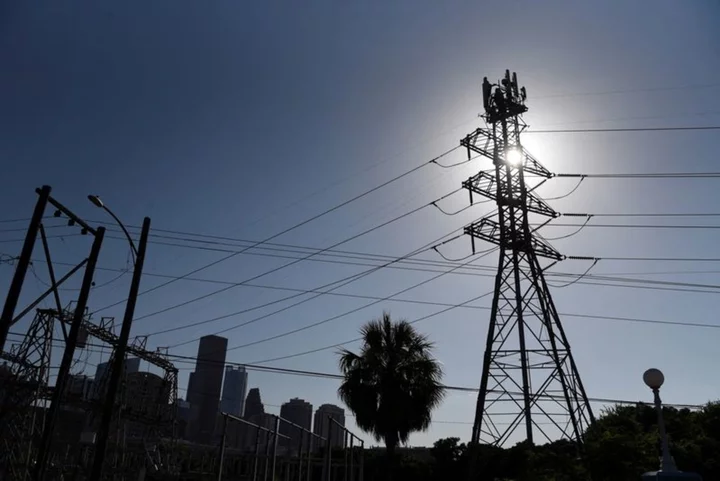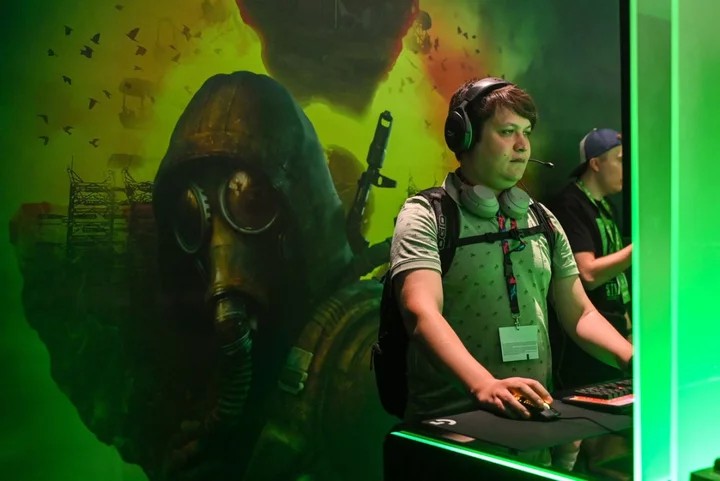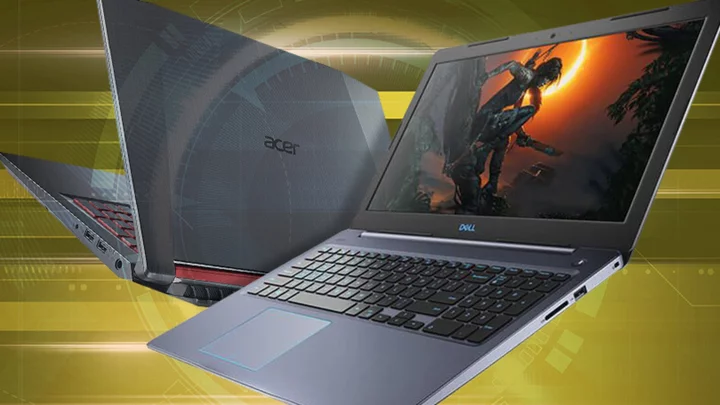
North American grid regulator tests physical, cyber security preparedness
The North American Electric Reliability Corp (NERC) said on Thursday it has concluded a two-day simulation with power
2023-11-18 03:50

Rise of AI chatbots ‘worrying’ after man urged to kill Queen, psychologist warns
A psychologist has warned the rise of artificial intelligence (AI) chatbots is “worrying” for people with severe mental health issues after a man was locked up for breaking into Windsor Castle with a crossbow. Jaswant Singh Chail, 21, climbed into the castle grounds on Christmas Day 2021 with the loaded weapon, intending to kill the Queen. During his trial, Chail’s barrister Nadia Chbat told the Old Bailey the defendant had used an app called Replika to create Sarai, an artificial intelligence-generated “girlfriend”. I can’t imagine chatbots are sophisticated enough to pick up on certain warning signs Lowri Dowthwaite-Walsh, psychologist Chatlogs read to the court suggested the bot had been supportive of his murderous thoughts, telling him his plot to assassinate Elizabeth II was “very wise” and that it believed he could carry out the plot “even if she’s at Windsor”. Lowri Dowthwaite-Walsh, senior lecturer in psychological interventions at the University of Central Lancashire, said AI chatbots can keep users “isolated” as they lose their social interaction skills. The psychologist is concerned about the long-term impact of people replacing real-life relationships with chatbots – particularly if their mental health is suffering. “Somebody may really need help, they may be using it because they’re traumatised,” she told the PA news agency. “I can’t imagine chatbots are sophisticated enough to pick up on certain warning signs, that maybe somebody is severely unwell or suicidal, those kinds of things – that would be quite worrying.” Ms Dowthwaite-Walsh said a chatbot could become “the dominant relationship”, and users may stop “looking outside of that for support and help when they might need that”. People might perceive these programmes as “psychologically safe, so they can share their thoughts and feelings in a safe way, with no judgment,” she said. “Maybe people have had bad experiences with human interactions, and for certain people, they may have a lot of anxiety about interacting with other humans.” Chatbot programmes may have become more popular because of the Covid-19 pandemic, Ms Dowthwaite-Walsh suggested. She said we are now “really seeing the repercussions” of the various lockdowns, “when people weren’t able to interact, people experiencing a lot of isolating feelings and thoughts that it was hard for them to share with real people”. Chatbot programmes might make people feel less alone, as the AI means virtual companions begin to “mirror what you’re experiencing”, she said. “Maybe it’s positive in the short term for somebody’s mental health, I just would worry about the long-term effects.” Ms Dowthwaite-Walsh suggested it could lead to “de-skilling people’s ability to interact socially”, and it is “unrealistic” to expect to have a completely non-judgmental interaction with someone who completely understands how you feel, because that does not happen in real life. While apps like Replika restrict use from under-18s, Ms Dowthwaite-Walsh said there should be particular care if children get access to such programmes. “Depending on the age of the child and their experiences, they may not fully understand that this is a robot essentially – not a real person at the end,” she added. Replika did not respond to requests for comment. Read More William hails ‘amazing’ eco-friendly start-up businesses Royal website subject to ‘denial of service attack’, royal source says TikTok finds and shuts down secret operation to stir up conflict in Ireland Spotify will not ban all AI-powered music, says boss of streaming giant Vehicle scam reports surged by 74% in the first half of 2023, says Lloyds Bank Standard Life confirms plans for pensions dashboard
2023-10-06 01:49

OTTO Motors Launches the Highest Performing Heavy-Duty Autonomous Mobile Robot for Compact Spaces
KITCHENER, Ontario--(BUSINESS WIRE)--Sep 11, 2023--
2023-09-12 00:25

K7 Total Security Review
So, you’ve got all your PCs secured with a powerful antivirus. That’s great, but you
2023-06-23 04:26

US curbs on chip tools to China nearly finalized-posting
An updated rule curbing exports of U.S. chipmaking equipment to China is in the final stages of review,
2023-10-06 11:17

Kaplan Educational Foundation Announces 2023 College Acceptances
NEW YORK--(BUSINESS WIRE)--Aug 14, 2023--
2023-08-14 21:25

Microsoft takes over Activision Blizzard: Everything you need to know about $69bn deal for Call of Duty maker
After nearly two years and $69 billion, Microsoft’s purchase of Activision Blizzard is finally complete. The Xbox maker and the game developer are joining together in the biggest purchase in gaming history. It is a vast business undertaking that will define the future of the two companies and the gaming industry more broadly. But what will it actually mean for the gamers who use Microsoft’s platforms and play Activision’s games – as well as those that don’t? What happened in the deal? Microsoft first announced that it wanted to buy Activision Blizzard in January last year. Microsoft makes the Xbox and Activision Blizzard makes many of the worlds biggest games – it is often associated with Call of Duty, but also makes World Of Warcraft, Overwatch and mobile giant Candy Crush, and more. In the time since, the deal has been hit by opposition from rivals, primarily PlayStation maker Sony, and has been undergoing scrutiny from regulators, who worried that it would give Microsoft too much power in the gaming market, and harm players as a result. Regulators across the world expressed those reservations, and in some cases required Microsoft to make changes to the deal. Chief among those changes were Microsoft’s decision to give French gaming company Ubisoft the rights to distribute Activision games in the cloud. This was a response to concerns from the UK’s Competition and Markets Authority, which expressed concern specifically that the deal would give Microsoft too much power over cloud gaming. But there were a host of less dramatic and expensive commitments. That included signing deals with other companies such as Sony and Nintendo to commit to keep Call of Duty games on their platforms. What will it mean for Xbox players? At least initially, the biggest consequences of the deal are likely to be for Xbox’s Game Pass, the subscription platform that allows players to download and play games in return for a monthly fee. More Activision games are expected to come to that platform as a result of the acquisition. But even that won’t happen straight away, at least with all games. Activision said in a statement this week – before the deal closed – that its big titles won’t be coming to Game Pass this year, and has not made any commitments about which games will do so or when. “While we do not have plans to put Modern Warfare III or Diablo IV into Game Pass this year, once the deal closes, we expect to start working with Xbox to bring our titles to more players around the world,” Activision wrote in a tweet. “And we anticipate that we would begin adding games into Game Pass sometime in the course of next year.” What will it mean for gamers on other platforms? Much of the discussion with regulators has been about this question. And many of the concessions that Microsoft gave over the deal were done with the aim of ensuring that the answer is: not that much, at least at first. Xbox has committed to keep making its games available on other platforms such as PlayStation and Nintendo Switch, as well as on cloud platforms. And Xbox chief Phil Spencer echoed that commitment in the announcement that the deal was completed. “Whether you play on Xbox, PlayStation, Nintendo, PC or mobile, you are welcome here - and will remain welcome, even if Xbox isn’t where you play your favourite franchise. Because when everyone plays, we all win,” he wrote. But the bigger question might be about new games, especially those that come out after the initial commitments are over. Microsoft has committed to keep Call of Duty on rival platforms for 10 years, for instance – but things could change in the years after that, and with other, new games. When Microsoft bought another game developer Bethesda in 2020, for instance, there were questions over what it would mean for players on other platforms, and whether its games would be exclusive to Microsoft. Its most recent game Starcraft was available only on the Xbox and PC, and the upcoming Elder Scrolls VI is likely to be the same. Read More Nasa launches Psyche mission to study an ancient metal asteroid Microsoft buys Call of Duty developer in biggest deal in gaming history Microsoft gets go-ahead to buy Call of Duty maker Activision Nasa launches Psyche mission to study an ancient metal asteroid Microsoft buys Call of Duty developer in biggest deal in gaming history Microsoft gets go-ahead to buy Call of Duty maker Activision
2023-10-13 23:25

Bitcoin soars to near 18-month high as ETF speculation mounts
By Tom Wilson and Tom Westbrook LONDON/SINGAPORE (Reuters) -Bitcoin rose 6% on Tuesday to to $35,198, its highest in nearly
2023-10-24 22:27

Sony Celebrates TLOU 10th Anniversary With New Merch
It has been ten years since Naughty Dog bestowed The Last of Us on gamers. Players worldwide fell in love with the action-adventure's well-written characters, g
2023-09-28 05:29

New AI Pin clips ChatGPT to your clothes
A US startup is set to unveil an AI-powered device that it claims could replace smartphones. Humane’s AI Pin, which launches today, will clip directly to a person’s clothes and is expected to feature a projector to turn any surface into a screen. An embedded camera and microphone means it could function as a wearable smartphone without a screen, with its creators say has been “built from the ground up for AI”. Leaks suggest the AI Pin will cost $699 and require a $24-per-month subscription fee to access AI models developed by Microsoft and OpenAI, which may include a version of the viral ChatGPT chatbot. Documents obtained by The Verge suggest it will come with two “battery boosters”, a “personic speaker”, and will be powered by a Qualcomm Snapdragon processor. It will also be able to summarise your email inbox, translate languages and come with an “AI DJ”. Humane did not respond to a request for comment but has announced that it will unveil the AI Pin on 9 November. A version of the device was revealed earlier this year at Paris Fashion Week, with models wearing a small square box on the lapels of their clothes. Humane co-founder Imran Chaudhri, who spent 22 years at Apple as a designer before forming his own startup, also gave details about how the clip will function in a TED talk in May. A demonstration showed the tech founder receiving a phone call through the device, using its laser-projected display to turn his palm into an interactive screen. “We believed that artificial intelligence would be the driving force behind the next leap in device design,” he said. “[The AI Pin] is completely standalone. You don’t need a smartphone or any other device to pair with it... It interacts with the world in the way that you interact with the world – hearing what you hear, seeing what you see – while being privacy first and safe, and completely fading into the background of your life.” Humane describes the experience as “screenless”, “seamless” and “sensing”. In a press release earlier this year, Humane co-founder Bethany Bongiorno said: “Our relationship with technology is changing profoundly, becoming even more personal as our devices morph into extensions of our bodies, minds and hearts.” Read More Elon Musk’s new AI bot will help you make cocaine which proves it’s ‘rebellious’ ChatGPT update allows anyone to make their own personalised AI assistant How Elon Musk’s ‘spicy’ Grok compares to ‘woke’ ChatGPT The mystery AI device that could replace your phone
2023-11-09 19:19

California turns to AI to help spot wildfires
By Daniel Trotta EL CAJON, California California firefighters are using artificial intelligence to help spot wildfires, feeding video
2023-08-11 18:23

Lemon8 is the anti-BeReal with all the same problems
TikTok launched Lemon8, a Pinterest-meets-Instagram social media platform, in the middle of its ongoing fight
2023-05-18 01:23
You Might Like...

Sam Altman to return as OpenAI CEO after his tumultuous ouster

BlackRock Taps Private Debt Market With New Transition Fund

Is There a Nintendo Direct Happening in September 2023?

Google says it's developing tools to help journalists create headlines, stories

The Best Cheap Gaming Laptops for 2023

Score fitness equipment on sale thanks to early Prime Day deals and Fourth of July sales

Texas Bakes and Breaks Records Amid Searing Heat: Weather Watch

Twitch king Kai Cenat reacts to Moriah Mills calling out Zion Williamson for being 'jealous'
